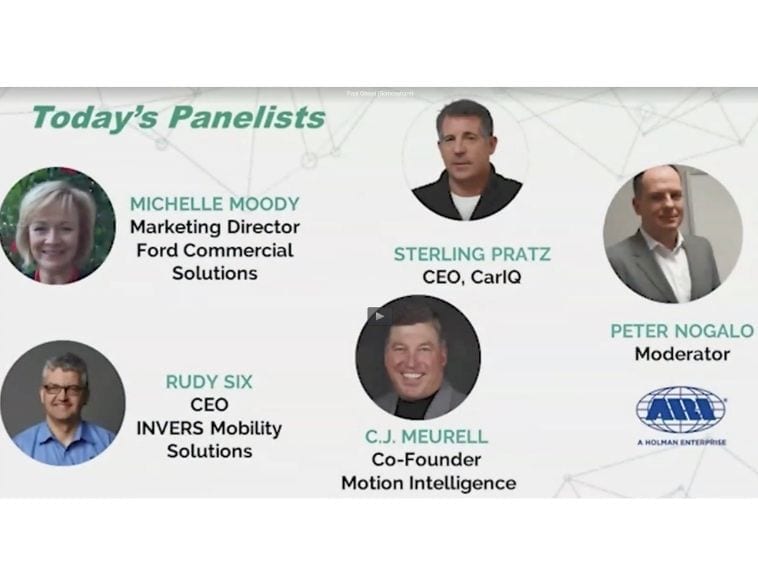New and emerging technologies are making the impossible very possible for fleets today.
As technologies change and advance, one of the challenges facing traditional fleets is the integration of new services into the existing fleet structure. How to do so effectively was the focus of a panel discussion moderated by Peter Nogalo, Marketing Manager for ARI.
The panel included a diverse group of industry experts including Tony Candeloro, Sr. VP – Technology & Operations at Holman Strategic Ventures; C.J. Meurell, Co-Founder of Motion Intelligence; Michelle Moody, Marketing Director at Ford Commercial Solutions; Rudy Six, CEO of INVERS Mobility Solutions; and Sterling Pratz, CEO of CarIQ.
The panel agreed that connectivity is becoming more ubiquitous and more available with more companies beginning to adopt connectivity solutions to improve their businesses. That said, it’s not an easy step to take. Besides the costs involved, fleets have to factor in the challenges of implementation and the need for culture change.
It may not be an easy step to take, but according to Ford’s Michelle Moody, companies are moving ahead with technology like never before. “Fleets are increasingly adopting telematics,” she said. “I’m sure two years ago the penetration rate would have been somewhere in the 30 – 40% range. Now, we’re beginning to see that number up closer to 80% among the larger fleets.”
Sterling Pratz of CarIQ explained how his company harnesses the power of telematics to make it possible for vehicles to pay for certain expenses on their own, without involving the fleet operator. “We realized that today’s fleet vehicles are all surrounded by credit cards,” he said, explaining how CarIQ got started. “I think there’s a credit card for everything. And the challenge was—even though there are probably millions of credit cards being used to pay for expenses within the fleet industry—many of the processes are still manual. They’re quite complex and they require a lot of people. And we thought there must be a better way to do this.”
The better way was with technology. Pratz and his team came up with a way for vehicles to pay for things like fuel and tolls automatically, without a human being punching in numbers, and without banks worrying about fraud.
“So today,” he explained, “we have a system where we can actually take the telematics data of the vehicle, we can create a unique ID for that vehicle, and we enable that vehicle to then communicate directly with a merchant, say a fuel provider, and pay for that service automatically.”
Distracted driving
C.J. Meurell from Motion Intelligence discussed the problem of distracted driving. To eliminate it, Meurell said you have to understand why it’s there in the first place. “We’re completely convinced it’s because we’re addicted to technology,” he said. “And the younger we are, the stronger the addiction is.”
Meurell believes fleets can tackle the problem with technology. “When the driver approaches the vehicle, our technology automatically detects the driver and our app wakes up on the driver’s mobile device,” he explained. “And when the vehicle begins to move, our technology safely enforces the fleet’s driver mobile device policy. The display on their phone locks and they get a 911 button on the phone. And that’s it.”
The phone can also be set to allow access to Google Maps, but nothing else. No other apps will work while the vehicle is in motion. “Some fleets allow their drivers to use Bluetooth hands-free,” he added. “So they can program up to four personal numbers—mom, dad, husband, wife, son, brother, daughter—and those four buttons will appear on the screen when the phone is locked.”
If the driver has another phone in the vehicle with him—perhaps a personal device—Meurell says his technology will detect it and send a warning to management that an unauthorized device is present and powered on. “An alert is sent to the supervisor that the driver now has a rogue device in their presence while the vehicle is moving,” he added. “We take a GPS snapshot of the location of the vehicle, and we date and timestamp it.”
Employee acceptance
One of the biggest challenges to implementing any new technology is employee pushback. Getting drivers to accept and buy into new technologies can be an uphill battle for fleet managers.
Meurell said it’s necessary to start with a view of the bigger picture. “We always start at the top,” he explained. “What’s the culture of the company? Is there a culture of a safety culture? What’s the policy for drivers? Drivers may not be allowed to use a phone when they’re driving, but clearly some are using their phones right before the accident. So we sit down with the driver, and we say, ‘Look, there’s no privacy issue here. We’re not gathering any data from your phone, we don’t even know who you are, and we don’t know your phone number.’”
Drivers need to understand that there’s no personal data being collected on them, that they can still listen to their podcasts and playlists, that they can use a navigation app, and that their family can still get in touch with them if they need to. “Once you have that conversation with the drivers, then they start to come into the fold,” Meurell concluded.
Setting priorities
With so many new technologies available, and more coming to market at lightning speed, how can fleet managers figure out where to focus and how to set their priorities?
The answer, the panel agreed, is to determine what’s really important to your organization. The panel left fleet managers with a few questions to ponder: Fleets should look internally to determine what can be automated. What systems are highly manual today? And how do you use technology to automate those systems to be more cost-effective in the industry? How can you remove all the manual steps that are in your processes today? The answers to those questions will at least point fleet managers in the right direction.



